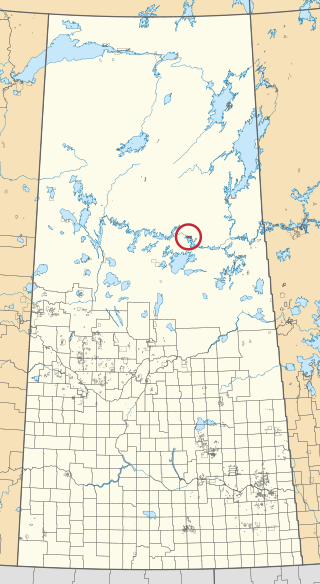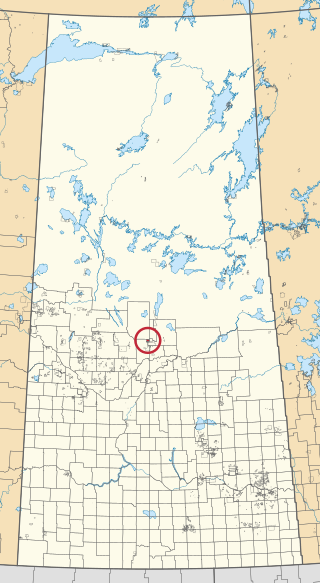
CBKA-FM is a Canadian radio station, broadcasting the CBC Radio One network at 105.9 FM in La Ronge, Saskatchewan.
The Lac La Ronge Indian Band is a Woodland Cree First Nation in northern Saskatchewan, it is the largest Cree band government in Canada and the largest First Nation in Saskatchewan. The administrative centre of the Lac La Ronge Indian Band is located in La Ronge.

Grandmother's Bay 219 is an Indian reserve of the Lac La Ronge Indian Band in Saskatchewan. Located on Otter Lake, part of the Churchill River system, it is 77 kilometers northeast of Lac la Ronge. In the 2016 Canadian Census, it recorded a population of 342 living in 101 of its 115 total private dwellings. In the same year, its Community Well-Being index was calculated at 44 of 100, compared to 58.4 for the average First Nations community and 77.5 for the average non-Indigenous community.

Lac La Ronge Provincial Park is located in the boreal forest of the north central part of the Canadian province of Saskatchewan within the Canadian Shield. Situated in the Churchill River system, this provincial park has close to 100 lakes and more than 30 canoe routes, many of which follow old fur trade routes. Summer activities include camping, hiking, boating, fishing, and swimming. In the winter, there's cross-country skiing, snowmobiling, and ice fishing. Saskatchewan's highest waterfall is in the park. Nistowiak Falls are located north of Lac La Ronge along the Rapid River.

Bittern Lake 218 is an Indian reserve of the Lac La Ronge Indian Band in Saskatchewan. It is 8 kilometres east of Prince Albert National Park.

Four Portages 157C is an Indian reserve of the Lac La Ronge Indian Band in Saskatchewan. It is 23 miles (37 km) north-east of La Ronge, and on the north shore of Lac la Ronge.

Fox Point 157D is an Indian reserve of the Lac La Ronge Indian Band in Saskatchewan. It is 16 miles south-east of La Ronge, and on the south-west shore of Lac la Ronge.

Fox Point 157E is an Indian reserve of the Lac La Ronge Indian Band in Saskatchewan. It is 18 miles south-east of La Ronge, and on an island near the south shore of Lac la Ronge.

Lac la Ronge 156 is an Indian reserve of the Lac La Ronge Indian Band in Saskatchewan. It is 10 kilometres southwest of Lac la Ronge. In the 2016 Canadian Census, it recorded a population of 2017 living in 441 of its 480 total private dwellings. In the same year, its Community Well-Being index was calculated at 50 of 100, compared to 58.4 for the average First Nations community and 77.5 for the average non-Indigenous community.

Little Hills 158 is an Indian reserve of the Lac La Ronge Indian Band in Saskatchewan. In the 2016 Canadian Census, it recorded a population of 0 living in 0 of its 0 total private dwellings.

Little Hills 158A is an Indian reserve of the Lac La Ronge Indian Band in Saskatchewan. It is 6 miles south-west of La Ronge, and on the north bank of the Little Hills River.

Little Hills 158B is an Indian reserve of the Lac La Ronge Indian Band in Saskatchewan. It is 8 miles southwest of La Ronge, and on the south-east shore of Bigstone Lake.

Little Red River 106C is an Indian reserve of the Lac La Ronge Indian Band in Saskatchewan. It is 34 kilometres north of Prince Albert. In the 2016 Canadian Census, it recorded a population of 354 living in 88 of its 98 total private dwellings. In the same year, its Community Well-Being index was calculated at 48 of 100, compared to 58.4 for the average First Nations community and 77.5 for the average non-Indigenous community.

Little Red River 106D is an Indian reserve of the Lac La Ronge Indian Band in Saskatchewan. It is 25 miles north of Prince Albert, and in Township 53, Range 1, west of the Third Meridian. In the 2016 Canadian Census, it recorded a population of 5 living in 1 of its 3 total private dwellings.

Morin Lake 217 is an Indian reserve of the Lac La Ronge Indian Band in Saskatchewan. It is 24 kilometres east of Lac la Ronge. In the 2016 Canadian Census, it recorded a population of 577 living in 135 of its 155 total private dwellings. In the same year, its Community Well-Being index was calculated at 45 of 100, compared to 58.4 for the average First Nations community and 77.5 for the average non-Indigenous community.

Old Fort 157B is an Indian reserve of the Lac La Ronge Indian Band in Saskatchewan.

Stanley 157 is an Indian reserve of the Lac La Ronge Indian Band in Saskatchewan. It is 56 kilometres northeast of Lac la Ronge. In the 2016 Canadian Census, it recorded a population of 1840 living in 451 of its 466 total private dwellings. In the same year, its Community Well-Being index was calculated at 52 of 100, compared to 58.4 for the average First Nations community and 77.5 for the average non-Indigenous community.

Stanley 157A is an Indian reserve of the Lac La Ronge Indian Band in Saskatchewan, Canada. It is 41 miles north-east of La Ronge, and 7 miles east of Stanley on the south shore of the Churchill River.

Sucker River 156C is an Indian reserve of the Lac La Ronge Indian Band in Saskatchewan. It is 230 kilometres north of Prince Albert. In the 2016 Canadian Census, it recorded a population of 416 living in 109 of its 124 total private dwellings. In the same year, its Community Well-Being index was calculated at 49 of 100, compared to 58.4 for the average First Nations community and 77.5 for the average non-Indigenous community.

Bow River is a river in the Northern Administration District of the Canadian province of Saskatchewan. The river begins at Ridge Lake of Bow River chain lakes in Clarence-Steepbank Lakes Provincial Park and flows in a northerly direction into Lac la Ronge and Lac La Ronge Provincial Park. Rapid River connects Lac la Ronge to the Churchill River. There are no communities nor settlements along the river's course.




















